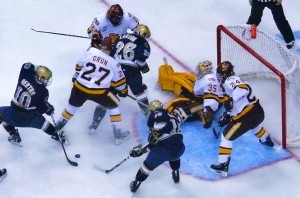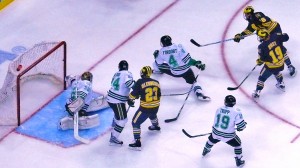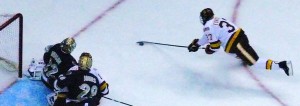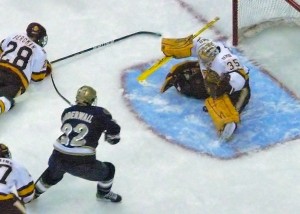PP lifts Reiter, UMD to 4-3 win

UMD goalie Kenny Reiter had the closest seat in Xcel Center to view Notre Dame's furious closing rally.
By John Gilbert
SAINT PAUL, MINN. — Kenny Reiter regained his lost touch in the third period of Thursday afternoon’s first NCAA Frozen Four semifinal, as Minnesota-Duluth struck for three power-play goals to propel the Bulldogs to a 4-3 victory over Notre Dame and a berth in Saturday night’s NCAA championship game.
The victory sends the Bulldogs (25-10-6) into Saturday’s 6 p.m. final against Michigan (29-10-4), which surprised top-seeded North Dakota 2-0 in the second game of a semifinal day that drew 19,139 to Saint Paul’s Xcel Energy Center. While Michigan will be seeking its record 10th NCAA crown, UMD will be seeking its first title, in only its second title game. The only previous UMD final was in 1984 at Lake Placid, where a 5-4 loss to Bowling Green in four overtimes still stings veteran Duluth fans.
“It’s great to be in position to win the championship — something that’s never been done,” said Jack Connolly, whose second-period goal stood up as the game-winner. “Our power play has been huge for us all year, and fortunately we were able to come through on it tonight.”
Notre Dame (25-14-5) gave UMD all it could handle, grabbing early leads of 1-0 and 2-1, and, after failing to subdue UMD’s power play through two periods, the Fighting Irish rallied from a 4-2 deficit by outshooting the Bulldogs 15-2 to make it a pressure-filled third period.
Freshman J.T. Brown, and juniors Mike Connolly and Jack Connolly scored power-play goals for UMD, and Kyle Schmidt got the lone equal-strength tally. “Our power play has been great all year,” said Fontaine, who assisted on all three power-play goals with clever passes, while freshman defenseman Justin Faulk also had three assists, all in the opening period.
UMD’s penalty killers were just as effective, holding Notre Dame scoreless on five power plays, and limiting the Irish to only two shots on those five opportunities. The Irish penalty killers did sting UMD’s power play for Calle Ridderwall’s shorthanded goal early in the third period to close the gap to 4-3 and leave 18 dramatic minutes before the Bulldogs could claim the victory.
“Obviously, it was a game dictated by one thing — special teams,” said Notre Dame coach Jeff Jackson. “They have an exceptional power play, and we couldn’t generate any offense on our power play.”
The Fighting Irish generated plenty of offense at the outset, although at a point in the tournament where great goaltending usually makes the difference, this one started off as a nightmare for both Reiter and Notre Dame’s Mike Johnson. UMD coach Scott Sandelin attributed it to nerves. “If you don’t have nerves in a game like this, you’re not human,” said Sandelin.
But this game raised the question of whether any shots might strike a goaltender. Notre Dame struck first, when Jack Costello gathered up the puck at center ice and rushed up the right side, shooting from the top of the right circle to beat Reiter on the first shot of the game at 0:49. UMD countered promptly enough, aided by its first power play. Fontaine kept the puck in at the left boards and fed center point, where
Faulk relayed a neat pass to Brown in the left circle. Brown either misfired on his shot or tried to pass to a teammate crossing in front of the goal, but in either case, the off-speed shot resulted in UMD’s first shot of the game, and went through Johnson’s legs at 3:04.
“It was a crazy start,” said Jackson, referring to five first-period goals. Notre Dame regained the lead at 2-1 at 9:46, when T.J. Tynan was wide to the right of the UMD goal where the rebound from Nick Larson’s long shot was headed. Despite almost no angle, Tynan got his shot past Reiter for a lead that lasted barely a minute.
Kyle Schmidt tied it 2-2 for UMD when he caught a hard, diagonal pass rushing up the left side. He veered toward the net and lifted his shot in, short side, at 10:52. UMD got another power play and took its first lead at 13:31 of the first period when Faulk passed in from center point to Fontaine, who immediately passed from the left circle to the slot and Mike Connolly quickly snapped a shot inside the left post. Despite being outshot 15-11 by the Irish, UMD led 3-2.
Faulk, who is from South St. Paul, now has 8 goals and 25 assists as the triggerman on the power play. “It was amazing be able to play here, in front of my friends and family,” said the freshman defenseman.
Faulk’s play was something Jackson admired. “Our special teams had been one of our staples, but it’s been disappointing this season,” said the Irish coach. “We don’t have a quarterback on the point like Faulk is.”
The Bulldogs took apparent command with a dominant second period, as the power play worked its magic again. This time Fontaine circled out to the top of the slot and passed in deep on the left side of the net to Brown, who quickly relayed a pass through a defenseman and across the goal-mouth to where Jack Connolly one-timed a shot into the net before Johnson could adjust. That goal came at 5:51, and the 4-2 margin grew in significance as the minutes passed.
When UMD got another power play early in the third, it was a chance to put the game away. Instead, it was the Irish — skating six freshman forwards and three more freshmen on defense — who clicked. Calle Ridderwall broke up the right side on what looked innocent enough, until he cut toward the slot and pulled up to fire a 40-foot missile that sailed past Reuter and cut the lead to 4-3 at 2:05.
The shorthanded goal helped the Irish respond to coach Jackson’s strong words from the second intermission, and they dominated the third period, while UMD seemed willing to try to sit on the one-goal lead. “They outshot us and outhustled us in the third period,:” said Faulk. “But we got the puck out of our end when we needed to.”
Jackson pulled Johnson for six attackers near the end, but Reiter had found his rhythm and stopped everything, while his scrambling defense held on to the final buzzer.
“We weathered the storm at the end,” said Sandelin. “When our backs are to the wall, we battle back. Sometimes I think we’re better when our backs are to the wall.”
In the second semifinal, Michigan’s quickness seemed to offset North Dakota’s explosive offense, which had established an 11-game winning streak and 15-game unbeaten finish. The Fighting Sioux had romped to the Midwest Region title by blitzing RPI 6-0 and Denver 6-1, but couldn’t get anything past Shawn Henwick — a senior who had been an uncomplaining third-string goalie for three years. Henwick stopped all 40 North Dakota shots, and the Wolverines gained the game-winning goal when Ben Winnett scored only his fourth goal of the season at 13:26 of the first period.

Michigan's Ben Winnett fired past Aaron Dell's glove for the 1-0 lead that stood up against North Dakota.
Winnett converted a rebound off the right pipe after Jon Merrill’s left point shot struck iron. Thereafter, it was a test of Michigan’s ability to use its size and quickness to harness North Dakota’s firepower, and Henwick coming through to stop everything that got through.
The Sioux outshot Michigan 40-19, including 11-3 in the second period and 15-6 in the third. But the good scoring chances could be counted on one hand as Michigan prevented North Dakota’s usual penetration to the net, and the Wolverines 19th shot came from Scooter Vaughan, into an empty net with 36 seconds remaining.
“They’re a better team,” said Berenson. “No way we can match up. They are as good as it gets. But the best team doesn’t always win. In one game, anything can happen.”
North Dakota coach Dave Hakstol saw his team’s 32-9-3 season and a closing 15-game unbeaten streak come to a sudden end. “I didn’t think it was going to end,” he said. “I don’t think anybody in our locker room considered the chance we’d lose. I’m proud of the standards our leaders set — it was not an option in any one person’s mind that we’d lose. There was no frustration in our game. We laid it on the line till the end of the game.”
Comments
Tell me what you're thinking...
and oh, if you want a pic to show with your comment, go get a gravatar!




 John Gilbert is a lifetime Minnesotan and career journalist, specializing in cars and sports during and since spending 30 years at the Minneapolis Tribune, now the Star Tribune. More recently, he has continued translating the high-tech world of autos and sharing his passionate insights as a freelance writer/photographer/broadcaster. A member of the prestigious North American Car and Truck of the Year jury since 1993. John can be heard Monday-Friday from 9-11am on 610 KDAL(www.kdal610.com) on the "John Gilbert Show," and writes a column in the Duluth Reader.
John Gilbert is a lifetime Minnesotan and career journalist, specializing in cars and sports during and since spending 30 years at the Minneapolis Tribune, now the Star Tribune. More recently, he has continued translating the high-tech world of autos and sharing his passionate insights as a freelance writer/photographer/broadcaster. A member of the prestigious North American Car and Truck of the Year jury since 1993. John can be heard Monday-Friday from 9-11am on 610 KDAL(www.kdal610.com) on the "John Gilbert Show," and writes a column in the Duluth Reader.